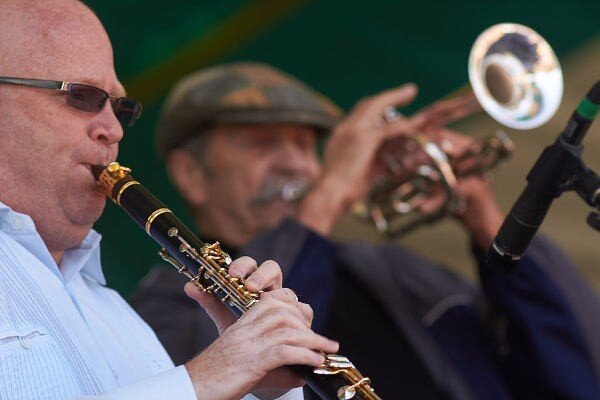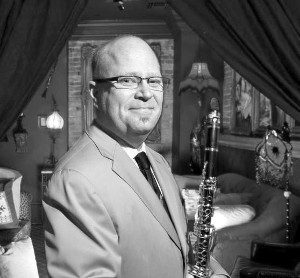Tim Laughlin [LOCK-lin] has been tabbed “The Swinging Son of New Orleans.” He determined early in his career that he wanted to separate himself from other clarinet players, deciding the best way to do that was not to play higher, faster or louder, but to take a quieter, more melodic approach.
Tim favors tunes with a degree of difficulty and humor. “Tone is the biggest thing to embrace and being able to make proper use of space. It’s important to tell a story, to have a lively conversation with fellow musicians fluent in a shared language.”
He also opted to write original songs for the 21st century. “I began writing in the early ’90s and enjoyed the results. It wasn’t so much a matter of trying to change or recreate the New Orleans sound, but to have these tunes reflect how New Orleans bands played them over the past 75 years. I wanted what I composed to be representative of the city where I have lived all my life. This is a happy, joyful place. New Orleans is a state of mind. We’re not in a big hurry, and we love people. The music reflects that. It’s about the ensemble, dance music, and movement.”
One of the dozen or so CDs Tim has recorded is The Isle of Orleans that was released in 2003. He was the first recent New Orleans clarinetist to produce an album of all original tunes, backed by a band that includes Connie Jones, Hal Smith, Lucien Barbarin, Jason Marsalis, Tom McDermott, John Royen, and Matt Perrine, among others. Some of his songs are included in the credits of numerous films and television shows. The most recent is an Eddie Murphy film, “Mr. Church,” to be released in November 2016.
Tom McDermott’s liner notes captured the moment: “If you live in New Orleans and make your living playing traditional jazz, you have some choices as to what music you’re going to play. You can cave in completely to tourist demand and blare out nothing but the Dixieland Top 40, then complain about how little you’re working. Or you can excavate the mustiest regions of the repertoire, perform neglected works by the 1923 “Hog Jowls” Jackson band, brag that nobody else ever plays that stuff, then complain about how little you’re working.
“With 20 years’ experience in the music wars, Tim Laughlin has done some of both. Fortunately, he started writing and performing his own tunes. Tim came to the conclusion that ‘If I’m going to play obscure music, it might as well be my own.'”
McDermott concluded, “For if music like traditional jazz is to survive, it not only needs fresh performers and audiences but new melodies to keep things from getting stale.”

Tim fell in love with the sound of the clarinet when he heard a young friend in his neighborhood play the instrument. He got his first horn at 9 (which today is a lamp in his home). His first teacher, Bill Bourgeois, was a childhood friend of Irving Fazola and Eddie Miller and played in Sharkey Bonano’s band and with Leon Prima. Tim’s first job was playing on a Mardi Gras float with high school classmates at 15.
When he was 17, he met Pete Fountain and eventually became a member of the clarinet icon’s Half-Fast Walking Club band, a popular krewe on Mardi Gras day. In 2009 following the Roosevelt Hotel’s post-Katrina restoration, the two headlined the reopening of the legendary Blue Room before sold-out crowds. When Tim and his wife had a private audience with Pope Francis at the Vatican, Tim was carrying “Ole Betsy,” the horn Fountain played in his early career. “We received a Papal blessing along with anything we were carrying with us at the time.”
When Hurricane Katrina hit the Gulf Coast, Tim and his bandmates were about to leave for a festival in South America, forcing them to drive all night to stay ahead of the storm and make their flight. After Katrina, the U.S. State Department sent Tim on a goodwill tour of Peru, Mexico, and Canada as a thank-you gesture for giving aid to the Gulf Coast. A concert in Merida, Mexico, raised $30,000 for the New Orleans Center for the Creative Arts to help replace lost instruments.
Besides Fountain, others who have had an influence on his playing include Kenny Davern, Jack Maheu, and Bob Wilber, all melodic players. His mentor Connie Jones, with whom Tim has played innumerable times over the past 20 years, taught him how to lead a band, the use of space and phrasing, and how to find the platinum notes. Keep it loose was the veteran cornetist’s advice. Pete invited Connie and Tim to join his band at Hollywood Casino in Bay St. Louis from 2009-2012. Tim also played and toured with the DUKES of Dixieland for four years (1989-93).
On the personal side, Tim and his wife Juliet enjoy hosting house concerts with friends and visitors at their home in keeping with the New Orleans tradition of “the salon.” Guest artists at these sold-out concerts have included Dick Hyman, Wendell Brunious, Don Vappie, and Evan Christopher. (Tim has written a handbook on how to host a house party.)
Before meeting his future wife in 2006 Tim was a committed renter and had spent years renting in the French Quarter, enjoying the flexibility and low maintenance. Juliet, who is an investor and owner of commercial properties, convinced him on the merits of ownership, and in 2008 they found a sprawling building for sale in the 800 block of Royal Street.
It was a classic Creole, three-story main house built in 1811, with a carriage house and courtyard at the rear. But extensive renovations were required, and workmen worked throughout the summer and fall so that by early December the house was ready to serve as the site of the couple’s wedding. The property currently is not just a home but a place of business with an art gallery fronting Royal Street, along with multiple rental apartments and parking spaces. The couple live on the second floor which features a spacious ballroom where concerts and rehearsals are held.
Tim has found his niche as a staple of the Crescent City music scene where on any night he may be holding forth playing his favorite instrument at the Palm Court Jazz Cafe, Bombay Club Martini Bar, Snug Harbor or on the Steamboat Natchez.
He sums it all up by saying, “My biggest delight is knowing I am continuing a great tradition of keeping a timeless art form alive, and making a living at it.”
Lew Shaw started writing about music as the publicist for the famous Berkshire Music Barn in the 1960s. He joined the West Coast Rag in 1989 and has been a guiding light to this paper through the two name changes since then as we grew to become The Syncopated Times. 47 of his profiles of today's top musicians are collected in Jazz Beat: Notes on Classic Jazz.Volume two, Jazz Beat Encore: More Notes on Classic Jazz contains 43 more! Lew taps his extensive network of connections and friends throughout the traditional jazz world to bring us his Jazz Jottings column every month.






















